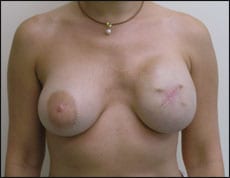While there are many approaches to lower lid blepharoplasty, each potential candidate for the procedure has different needs that can be addressed by a customized procedure. It is the purpose of this paper to focus on those patients who have a combination of pseudoherniation of lower eyelid fat combined with a nasojugal groove. For many years, patients with a nasojugal groove have been treated in a similar fashion to patients without a nasojugal groove. This conventional procedure involved the removal of excess skin and addressed the removal of fat in the areas where pseudo herniation of fat had occurred.
The nasojugaI groove is frequently characterized by a variable depression of the skin overlying the bony infraorbital rim. In patients with a prominent nasojugal groove, a minimal amount of soft tissue exists between the skin and the infraorbital rim. The nasojugal groove is highlighted and deepened by the pseudoherniation of fat directly above the infraorbital rim, because it creates a shadow and makes the “dark circle” even worse.

Figure 1. Note the anatomic relationship of the orbital fat to the conjunctiva, lower-lid retractors, and orbital septum.

Figure 2. Note the anatomic relationship of the orbital fat to the arcus marginalis and the sub-orbicularis oculi fat. The arcus marginalis represents the attachment of the orbital septum to the inferior orbital rim.
Over 5 years ago, procedures were popularized to attempt to improve the nasojugal groove, when indicated, while performing a lower lid blepharoplasty sty in a conventional manner. The concept was to reposition the pseudoherniated fat over the infraorbital rim, thereby decreasing the prominence of the nasojugal groove.
Several procedures have been introduced to attempt to reposition “living” fat with its original blood supply into the area of the nasojugal groove superficial and inferior to the infraorbital rim. Some of these may involve a transconjunctival approach, a transconjunctival approach with a lateral canthotomy, or a transcutaneous approach using a skin-muscle flap.
The method that works best in the hands of the senior author (Mittleman) is the transcutaneous approach using a skin-muscle flap with direct suturing of pseudoherniated fat to the periosteum inferior to the infraorbital rim. Comprehension of the three-dimensional anatomy of the orbit as noted in Figures 1 and 2 and the changes that occur in the periorbital and facial soft tissues with aging will help the surgeon with perioperative planning.
To optimize the procedure, the patient must be evaluated and marked in the sitting position immediately prior to surgery. This will enable the surgeon to have a clear mental picture of the nasojugal groove, as well as the specific fat pads that may be bulging in the medial, central, and/or lateral compartments. The author prefers a local anesthetic solution containing lidocaine, bupivacaine, fresh epinephrine, and hyaluronidase. The hyaluronidase helps minimize any distortion of soft tissue due to local infiltration. The patient and surgeon may choose to use local anesthesia alone, local with intravenous sedation, or local with general anesthesia.
The senior author first approaches excess skin of the lower eyelids using a pinch technique popularized by Morey L. Parks, MD, and Frank M. Kamer, MD.
When skin is excised in this manner, the underlying orbicularis oculi is clearly exposed. A stab incision is made through the orbicularis oculi lateral to the lateral canthus. The stab incision is carried down to, but not through, the orbital septum. If possible, the skin-muscle flap is elevated superficial to the orbital septum in a bloodless plane.
With the use of dissecting tissue scissors, the elevation is carried superiorly toward the tarsus of the lower eyelid and inferiorly toward the infraorbital rim. With this accomplished, a horizontal incision is made through the orbicularis oculi 2 mm below the tarsus of the lower eyelid. Hemostasis is achieved with bipolar electrocautery.
The goal now is to continue elevation in the plane deep to the orbicularis oculi onto the infraorbital rim from the medial canthus to the lateral canthus. At this point, one may continue the elevation in a supraperiosteal plane for one or more centimeters inferior to the infraorbital rim or in a subperiosteal plane for the same distance. Both methods are effective; however, the senior author favors the supraperiosteal plane. Regardless at what level the undermining is achieved, the pseudoherniated fat will eventually be sutured to the periosteum. Excellent hemostasis must be achieved throughout the procedure. In the supraperiosteal plane dissection, one may frequently visualize the suborbicularis oculi fat (SOOP) in the central portion of the undermined area.
With the undermining accomplished, the surgeon is able to clearly visualize the pseudoherniated fat in the respective compartments, the periosteum, and sometimes the SOOF. The surgeon can then, without altering the blood supply, reposition each fat pad from its position above the infraorbital rim to a position approximately 1 cm inferior to the infraorbital rim. The most difficulty is encountered in repositioning the most medial part of the medial fat pad and the most lateral part of the lateral fat pad. Sometimes, only one or two of the three fat pads need to be repositioned, depending on the areas of prominence of the nasojugal groove. Of note, in patients who have an enormous amount of pseudoherniating fat, one would have to excise some of the fat that is not needed as a cushion between the skin and the periosteum. Once repositioned, the fat pads are sutured to the periosteum using 6-0 colored polypropylene suture. Usually, five or six sutures are used to create this cushion of fat between the bone and the overlying thin skin of the preoperative nasojugal groove.
After the fat is repositioned, it is advantageous to have a smooth contour to reflect a similar external result. Furthermore, when using the supraperiosteal elevation technique, it is sometimes possible to place the suture through both the fat pad and the SOOF, thus pulling some of the SOOF in a superior direction while simultaneously pulling some of the repositioned fat pads in an inferior direction. It is extremely important that the repositioning of the fat, with or without a thin layer of orbital septum on it, does not create any tension on the lower eyelid margin or eyelashes.

Figure 3. Note the lack of pseudoherniating fat and the softening of the nasojugal groove following transcutaneous lower-lid blepharoplasty with fat repositioning.
With this accomplished, the skin-muscle flap is put back in position. If a small amount of muscle needs to be excised, that may be performed at that time. At this point, an orbicularis oculi suspension suture is placed using a 5-0 or 6-0 polypropylene suture pulling the lateral orbicularis oculi to the periosteum at the level of the lateral canthus. The orbicularis oculi suspension suture described above minimizes the chance of postoperative scleral show or lateral rounding for the near future and the long-term future. With this completed, the skin is approximated with virtually no tension using 6-0 polypropylene suture.
A significant number of patients are not candidates for this procedure. For example, some patients do not have a significant nasojugal groove. Other patients, while having a deep nasojugal groove do not have enough fat to perform a successful fat repositioning procedure. In these patients, one has the option to use fat grafts or alloplastic implants. Each patient needs to be assessed on an individual basis.
Harry Mittelman, MD, is a diplomate of the American Board of Facial Plastic and Reconstructive Surgery, and the American Board of Cosmetic Surgery. Adam D. Schaffner, MD, is a fellow in facial plastic and reconstructive surgery.





